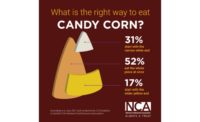Corn-a-Plenty
By Deborah Cassell
Mi Rancho’s “cornucopia” of Mexican-inspired products includes white and yellow corn tortillas and chips, as well as frozen flour-based products such as quesadillas, for the enjoyment of restaurant patrons both nationwide and overseas.
Manuel Berber was corn-bred, so to speak. As a kid, the now president of Mi Rancho remembers watching the women in his father’s factory pulverize kernels into masa by hand while on their knees, using heavy rolling pins on big stone slabs. Today, a statue of one worker doing just this sits in the company’s entryway, a reminder of the company’s humble beginnings.
The stone metate y mano no longer is an efficient means of producing dough — especially on a large scale — but Berber still likes to do things the old-fashioned way. Rather than purchasing dehydrated corn flour and adding water to it — a step that actually causes the corn to lose its flavor — his company continues to cook, steep and grind its own white and yellow corn into fresh masa, which it then uses to make tortillas and chips, primarily for restaurants and other foodservice entities.
Although the process is more costly, “we want to set ourselves apart,” explains Ken Sanchez, vice president of sales and marketing. That said, “The growth is on the flour side,” he notes.
This is why the company’s 100,000-sq.-ft. plant — which sits on about four acres of land just a stone’s throw away from the Oakland, Calif., airport — produces both flour and corn products. The facility — which is overseen by vice president of operations Joe Santana — houses four 60,000-lb. silos, two containing corn and two with white wheat flour. Half the company’s corn lines are used to produce table tortillas, while the other half makes tortillas for chips. Mi Rancho’s more than 150 employees make some 2 million tortillas and chips per day.
Talk about an abundance.
Más Masa
In making its tortillas, Mi Rancho uses only California-grown, GMO-free corn. To start, the corn is pumped out of a 3,000-lb. tank and cooked for 40 minutes before being steeped for 8-12 hours, depending on how dry or soft the customer wants the chip or tortilla to be. This steeping process is similar to fermenting, Sanchez says, and gives the product shelf life while busting open the kernels.
Next, the corn goes through a tumbler that takes out the hull and removes the skin. It then is drained and washed in a corn washer. Afterwards, it goes into a grinder to become masa, which is “100% corn,” as Sanchez points out.
The masa is dumped into a hopper and then onto a conveyor, and transferred to the production line to make tortillas. These tortillas make three passes through a tunnel oven at three temperatures, starting at 500°F. They are baked for 20-25 seconds before being cooled to a final temperature of 75°F. After cooling, the tortillas are hand-bagged and -boxed.
On the day of Snack Food & Wholesale Bakery’s visit, Mi Rancho was making 6-in. yellow corn tortillas on a line that produces 6,500 dozen pieces an hour — just a drop in the bucket for this West Coast powerhouse.
Flour Power
The flour tortilla process differs from the corn in several ways. To start, flour is mixed with water and fat and incorporated into the dough in an 800-lb. horizontal mixer. Because the dough has leavening in it, it requires some time to relax. Afterward, an eight-pocket divider/rounder cuts the dough into balls. The balls rest in an intermediate proofer for 11 minutes before being pre-pressed and then hot-pressed under 1,200-1,800 lb. of pressure.
Next, the tortillas are baked in a three-pass tunnel oven at around 420°F for 20 seconds. They then are cooled on a belt until the products reach 75-78°F. Lastly, the tortillas are fed into a counter/stacker before being packaged and sealed by hand. The finished product is placed in a cooling room at 75°F.
On the day of SF&WB’s visit, Mi Rancho was producing 14-in. flour tortillas, perfect for the ubiquitous wraps that now pervade American restaurants nationwide.
Although tortillas are Mi Rancho’s bread and butter, so to speak, tortilla chips are big business, too. Whether flour or corn in nature, loose tortillas sit in a staging area for 12 hours before being cut into four or six pieces to make chips. Most restaurants like bigger wedges, Sanchez notes, while some traditional eateries actually prefer to cut the tortillas themselves.
Meeting Standards
Like other snacks and baked goods, tortillas require a number of safety checks, and the equipment used to make them requires technology upgrades, all of which is top of mind for Mi Rancho.
The company’s Quality Assurance lab keeps records of all items, which are run with code dates, for recall purposes. It also does pH and moister tests, and regularly takes measurements and samples off every line.
“There’s a lot of changeover because we do so much,” Sanchez adds. He adds that Mi Rancho has become very automated over the last five years.
“We’re constantly upgrading our equipment,” Berber says. “We will always look for ways to improve our facilities.”
It’s no wonder the plant received a superior rating from AIB International.
“We’re a fresh company, we do fresh product,” Sanchez says. To that end, Mi Rancho’s products ship out within 1 to 2 days of production. Product is staged during the day and shipped out at night on eight docks. Distribution is nationwide, and some items go overseas, as well.
The company’s profits go back into the business as a means of growth and efficiency, Sanchez says.
Perhaps as a result, few tortilla producers have “corn-ered” the market like Mi Rancho. SF&WB



